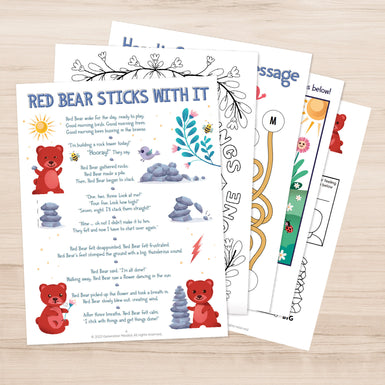I love my kids to the moon, and I feel like my actions speak for it. I mean, they’ve been my heartbeat for the last 15 years, and every decision I’ve made and all I have done has been out of love for these two boys. It’s why I spent hours on end playing with them and countless nights telling stories and laying with them until they drifted off. It’s why I showed up to every game, every play, and every concert. It’s the reason I’ve chauffeured them to and fro, washed a gazillion loads of their laundry, and…and…you get the idea. I mean, how could they even question it for one second? But, to be loved is not the same as to feel loved. Unless you’re speaking their love language, your child may not be receiving the message very clearly.
What is a Love Language?
A love language is a particular way someone gives and receives love. In The 5 Love Languages of Children, authors Gary Chapman and Ross Campbell outline the 5 different ways children receive love. All children receive love through each language, but for each child, there is one particular that has the loudest voice.
Chapman says, “Love can be expressed and received in all five languages. However, if you don’t speak a person’s primary love language, that person will not feel loved, even though you may be speaking the other four. Once you are speaking his or her primary love language fluently, then you can sprinkle in the other four, and they will be like icing on the cake.”
According to Chapman, there are 5 separate love languages. They are:
- Words of affirmation
- Gifts
- Acts of service
- Quality time
- Physical touch
How can you tell what your child’s love language is? If you have time, you can take this assessment. If not, just think about how your child shows love.
- Do they tell you they love you?
- Do they bring you a fist full of dandelions?
- Do they offer to help you with a chore?
- Do they ask to spend time with you or tell you sweet things?
- Do they show love to you with cuddles and physical affection?
Also consider what they’re often asking you for. “Mommy, can you buy me this bear?” “Daddy can we go out for ice cream?” These are clues as to how they give and receive love.
Showing Love in Each Language
Once you have figured out your child’s love language, let’s look at some ways you can speak that language so that they feel truly and deeply loved.
Words of Affirmation
Every child needs to hear words of encouragement, but for children whose love language is words of affirmations, it’s a lifeline. Be aware that these children also are more deeply wounded by criticism, harsh tones of voice, and negative body language. Here are 5 ways to speak this language:
- Place sweet notes in their lunchbox, on their pillow, or stick to their mirror.
- Notice their positive behaviors and personal strengths and verbally affirm those.
- Say “I love you” first and say it often.
- Give them a list of the things you like about them.
- Give them a special nickname.
Gifts
It’s true, all children love to receive gifts. Who doesn’t? But this language isn’t about being spoiled or collecting material things but about the thought behind it. It’s a way to show them that you care and that you were thinking of them. You can speak this language by:
- Cook them their favorite meal or treat.
- Send them mail.
- Make them a friendship bracelet.
- Pick a bouquet of flowers.
- Give a meaningful gift like a personalized item or something handmade.
Acts of service
Some children feel most loved when you do something for them. It’s about going out of your way to meaningfully help them. Acts of service help these children feel taken care of, and that speaks “love” to them. Here are 5 ways to show love to these kids:
- Do one of their chores for them.
- Teach them how to do something like crocheting or cooking.
- Pamper them with a “spa day” at home.
- Bring them a drink and a snack without being asked.
- Rub their feet or give a back rub.
Quality time
Quality time says “you’re important to me and I like hanging out with you.” If this is your child’s love language, it means they appreciate the simplicity of human interaction. They crave connection - to be seen, heard, and understood. Show your love by:
- Go on parent-child dates.
- Read together.
- Watch a movie or show together without phones or distractions.
- Offer your undivided attention while practicing active listening.
- Create meaningful traditions together.
Physical touch
Some people feel most loved when they receive a physical connection. It makes sense because skin-to-skin contact triggers the release of certain “feel good” hormones. If this is your child’s love language, try:
- Walking hand in hand.
- Offering high fives and fist bumps often.
- Brushing their hair.
- Cuddling up together for a story.
- Give lots of hugs and kisses.
Knowing and speaking your child’s love language will be pivotal in your parenting and in your relationship with your child. When children feel truly loved, they are more cooperative and receptive to our lessons, making parenting more joyful. And of course, a child who feels loved will be happier and feel more connected to you. Practice speaking your child’s love language every day and see what a difference it makes in your home!






















